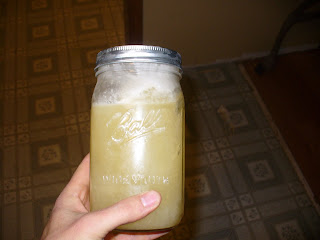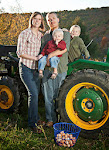I wrote
HERE about my efforts dealing with the State Hwy Dept to get an easement to build a bridge on the edge of our property boundary with the state to gain vehicular access to our hillside pasture.
The results were mixed. The guys that came out were pleasant, and in my opinion, reasonable. There are rules that they have to abide by. So here's what we worked out.
When they built I-540, the state put up a gate showing an old drive at the foot of our pasture, the state will recognize that as a common use access, much like the road to our house. The issue is how to get to that gate, and how to cross the creek.
 The common use access can be seen just to the left of my elbow
The common use access can be seen just to the left of my elbowAny use of a bridge will require a hydrological study by a civil engineering firm (ie. spend lots of $ for someone to tell me all the things that I already know) and be built to their standards. I'd also have to create a bond for the state to hold...etc, etc, etc. There's a valid point here though, that a bridge that gets swept away will tumble down creek and become the state's problem - as happened further south of here when a guy built a huge concrete bridge and it tumbled downstream into a state bridge off Hwy 71.
The state has no problem with me driving through the creek though, as long as we concrete the crossing point to mitigate erosion and they have a hand in the planning. They'll even let me use shale outcroppings from my land to build the road. Pretty reasonable. On top of this, I think there's a bedrock shelf about 6 inches in the current crossing spot, so we may be able to avoid concreting in the streambed all together.

 Welcome little guy!
Welcome little guy!

 Our big male, Alfredo, is too scared of the fence, but Feta is a notch or two smarter than Fredo, and always seems to find our fencing weaknesses. This time it was a high spot in the fencing were she's been able to slip under the hot-wire. Apparently I'd noticed this spot a while back, but I must not have had any insulators on me, because as you can see below, the t-post is definitely insulator poor. I fixed the problem, we'll see what Feta finds in the next week or so!
Our big male, Alfredo, is too scared of the fence, but Feta is a notch or two smarter than Fredo, and always seems to find our fencing weaknesses. This time it was a high spot in the fencing were she's been able to slip under the hot-wire. Apparently I'd noticed this spot a while back, but I must not have had any insulators on me, because as you can see below, the t-post is definitely insulator poor. I fixed the problem, we'll see what Feta finds in the next week or so! The snow sure does make the pasture pretty, but I still can't wait for summer!
The snow sure does make the pasture pretty, but I still can't wait for summer!
 So we've just about exhausted our supply of meat chickens we put up last year, in fact, we only have 3 left. Next year, I'd like to put up around 60 birds for our own use.
So we've just about exhausted our supply of meat chickens we put up last year, in fact, we only have 3 left. Next year, I'd like to put up around 60 birds for our own use. For supports, we used cut up telephone poles that I salvaged from some construction work at my job. The poles were extremely heavy.
For supports, we used cut up telephone poles that I salvaged from some construction work at my job. The poles were extremely heavy.  They're also creosoted pretty well -the poles were first put up in 1981, but have stood the test of time. The creosote is pretty critical, b/c as you'll see below some of the poles went into wet ground, it took a good bit of manhandling to get them into place.
They're also creosoted pretty well -the poles were first put up in 1981, but have stood the test of time. The creosote is pretty critical, b/c as you'll see below some of the poles went into wet ground, it took a good bit of manhandling to get them into place.
 2x8 nailers were put up onto the shop wall and the rafters hung from them (sans roofing).
2x8 nailers were put up onto the shop wall and the rafters hung from them (sans roofing).  Once the rafters were up, the fascia went up and the rafters were attatched. The pic below is kind of confusing. The fascia and the rafter are around 1/16 in too short, so we're pulling the fascia into the rafter.
Once the rafters were up, the fascia went up and the rafters were attatched. The pic below is kind of confusing. The fascia and the rafter are around 1/16 in too short, so we're pulling the fascia into the rafter.

